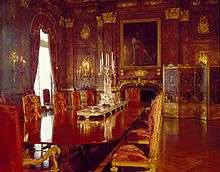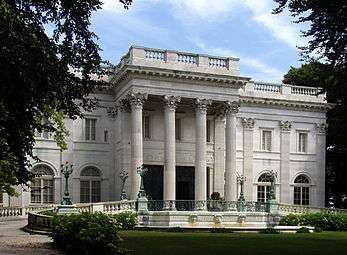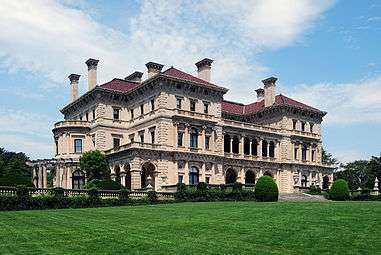Marble House
|
Marble House | |
|
The western facade, facing Bellevue Avenue | |
| Location |
596 Bellevue Avenue Newport, Rhode Island |
|---|---|
| Coordinates | 41°27′43″N 71°18′20″W / 41.46194°N 71.30556°WCoordinates: 41°27′43″N 71°18′20″W / 41.46194°N 71.30556°W |
| Built | 1888–92 |
| Architect | Richard Morris Hunt |
| Architectural style | Beaux Arts |
| Part of | Bellevue Avenue Historic District (#72000023) |
| NRHP Reference # | 71000025 |
| Significant dates | |
| Added to NRHP | September 10, 1971[1] |
| Designated NHL | February 17, 2006[2] |
| Designated NHLDCP | December 8, 1972 |
Marble House is a Gilded Age mansion at 596 Bellevue Avenue in Newport, Rhode Island, now open to the public as a museum run by the Preservation Society of Newport County. It was designed by the society architect Richard Morris Hunt. For an American house, it was unparalleled in design and opulence when it was built.[2] Its temple-front portico, which also serves as a porte-cochère, resembles that of the White House.[3]
History
The mansion was built as a summer "cottage" retreat between 1888 and 1892 for Alva and William Kissam Vanderbilt. It was a social landmark that helped spark the transformation of Newport from a relatively relaxed summer colony of wooden houses to the now legendary resort of opulent stone palaces. The fifty-room mansion required a staff of 36 servants, including butlers, maids, coachmen, and footmen.[4][5] The mansion cost $11 million ($260,000,000 in 2009 dollars) of which $7 million was spent on 500,000 cubic feet (14,000 m³) of marble.[3][5][6] Vanderbilt's older brother Cornelius Vanderbilt II subsequently built the largest of the Newport cottages, The Breakers, between 1893 and 1895.[7]
When Alva Vanderbilt divorced William in 1895, she already owned Marble House outright, having received it as her 39th birthday present.[8] Upon her remarriage in 1896 to Oliver Hazard Perry Belmont, she relocated down the street to Belmont's mansion, Belcourt. After his death, she reopened Marble House and added the Chinese Tea House on the seaside cliff, where she hosted rallies for women's suffrage.[3]
Alva Belmont closed the mansion permanently in 1919, when she relocated to France to be closer to her daughter, Consuelo Balsan. There she divided her time between a Paris townhouse, a villa on the Riviera, and the Château d'Augerville, which she restored.[8] She sold the house to Frederick H. Prince in 1932, less than a year before her death. In 1963 the Preservation Society of Newport County bought the house from the Prince Trust, with funding provided by Harold Stirling Vanderbilt, the Vanderbilt couple's youngest son. The Trust donated the furniture for the house directly to the Preservation Society.[9]
The mansion was added to the National Register of Historic Places on September 10, 1971. The Department of the Interior designated it as a National Historic Landmark on February 17, 2006.[2] The Bellevue Avenue Historic District, which includes Marble House and many other historic Newport mansions, was added to the Register on December 8, 1972 and subsequently designated as a National Historic Landmark District on May 11, 1976.[1]
Design
Marble House is one of the earliest examples of Beaux-Arts architecture in the United States, with design inspiration from the Petit Trianon at the Palace of Versailles.[2] Jules Allard and Sons of Paris, first hired by the Vanderbilts to design some of the interiors for their Petit Chateau on Fifth Avenue in Manhattan, designed the French-inspired interiors of Marble House also.[2] The grounds were designed by landscape architect Ernest W. Bowditch.[7]
The mansion is a U-shaped building. Although it appears to be a two-story structure, it is actually spread over four levels. The kitchen and service areas are located on the basement level, reception rooms on the ground floor, bedrooms on the second floor, and servant quarters on the hidden, uppermost level. The load-bearing portion of the walls are brick, with the exterior faced in white Westchester marble. Here Hunt adapted French neoclassical architectural forms of the seventeenth and eighteenth centuries to enliven the Beaux-Arts detailing.[5]
The facade of the mansion features bays that are defined by two story Corinthian pilasters. These frame arched windows on the ground floor and rectangular ones on the second on most of the facade. A curved marble carriage ramp, fronted by a semi-circular fountain with grotesque masks, spans the entire western facade. The masks serve as water spouts. The center of this facade, facing Bellevue Avenue, features a monumental tetrastyle Corinthian portico. The north and south facades match the western in basic design. The eastern facade, facing the Atlantic Ocean, is divided into a wing on each side. These wings semi-enclose a marble terrace and are surrounded by a marble balustrade on the ground floor level. The inset central portion of this facade differs from the others, with four bays of ground floor doors topped by second floor arched windows.[5]

The interior features a number of notable rooms. Entrance into the mansion is through one of two French Baroque-style doors, each weighing a ton and a half. Both are embellished by the monogram "WV" set into an oval medallion. They were made at the John Williams Bronze Foundry in New York.[5] The Stair Hall is a two-story room that features walls and a grand staircase of yellow Siena marble, with a wrought iron and gilt bronze staircase railing. The railing is based on models at Versailles. An 18th-century Venetian ceiling painting featuring gods and goddesses adorns the ceiling.[5]
Architect Richard Morris Hunt hired Giuseppe Moretti to produce the interior's marble friezes and statuary, including work on bas-reliefs of Hunt and Jules Hardouin Mansart, the master architect for Louis XIV during the construction of Palace of Versailles; and which stood side by side on the mezzanine level of the staircase. The Grand Salon, designed by Allard and Sons, served as a ballroom and reception room. Designed in the Louis XIV style, it features green silk cut velvet upholstery and draperies. The originals were made by Prelle. The walls are carved wood and gold gilt panels representing scenes from classical mythology, inspired by the panels and trophies adorning the Galerie d'Apollon at the Louvre. The ceiling features an 18th-century French painting in the manner of Pietro da Cortona depicting Minerva, with a surround adapted from the ceiling of the Queen’s Bedroom at Versailles.[5]
The Gothic Room, in the Gothic Revival-style, was designed to display Alva Vanderbilt's collection of Medieval and Renaissance decorative objects. The stone fireplace in the room was copied by Allard and Sons from one in the Jacques Cœur House in Bourges. The furniture was by Gilbert Cuel.[5] The Library is in the Rococo-style. It served as both a morning room and library. The doors and bookcases, in carved walnut, were a collaboration between Allard and Cuel.[5] The Dining Room features pink Numidian marble and gilt bronze capitals and trophies. The fireplace is a replica of the one in the Salon d'Hercule at Versailles. The ceiling is decorated painted with a hunting and fishing motif, with an 18th-century French ceiling in the center.[5] Mrs. Vanderbilt’s Bedroom, on the second floor, is in the Louis XIV style. The ceiling in this room is adorned with circular ceiling painting of Athena, painted circa 1721 by Giovanni Antonio Pellegrini. It was originally in the library of the Palazzo Pisani Moretta in Venice.[5]
Filming location
The interiors of the mansion have appeared in several films or television series. Scenes appearing in the 1972–73 television series, America, the 1974 film, The Great Gatsby, the 1995 miniseries The Buccaneers, the 1997 film Amistad, and the 2008 film 27 Dresses were shot here.[10] More recently, Victoria's Secret filmed one of their 2012 holiday commercials here.[11]
See also
| Wikimedia Commons has media related to Marble House. |
- List of Gilded Age mansions
- List of National Historic Landmarks in Rhode Island
- Beacon Towers, Long Island
- Mrs. O. H. P. Belmont House, Manhattan
- National Register of Historic Places listings in Newport County, Rhode Island
References
- 1 2 National Park Service (2010-07-09). "National Register Information System". National Register of Historic Places. National Park Service.
- 1 2 3 4 5 "Marble House". National Historic Landmark summary listing. National Park Service. Retrieved December 12, 2012.
- 1 2 3 Yarnell, James L. (2005). Newport Through Its Architecture: A History of Styles from Postmedieval to Postmodern, pp. 137-41. University Press of New England.
- ↑ "Alva Vanderbilt Belmont". Class and Leisure at America's First Resort. University of Virginia. Retrieved December 12, 2012.
- 1 2 3 4 5 6 7 8 9 10 11 "Marble House" (PDF). National Historic Landmark Nomination. National Park Service. Retrieved December 12, 2012.
- ↑ "Newport Rhode Island Mansions". "Newport Rhode Island Inn Mansion Tours". Retrieved December 12, 2012.
- 1 2 Hopf, John T. (1976). The Complete Book of Newport Mansions.
- 1 2 Randall, Amanda Mackenzie (2006). Consuelo and Alva Vanderbilt: The Story of a Daughter and a Mother in the Gilded Age. Stuart. pp. 431–435. ISBN 978-0-06-621418-4.
- ↑ Craven, Wayne (2009). Gilded Mansions: Grand Architecture and High Society, p. 170. W. W. Norton & Company.
- ↑ "Marble House - 596 Bellevue Avenue, Newport, Rhode Island, USA". Internet Movie Database. IMDb.com, Inc. Retrieved December 12, 2012.
- ↑ "Exclusive! Behind the Scenes Look at the Victoria's Secret 2012 Holiday Campaign". StyleList. AOL Corp. Retrieved December 20, 2012.

